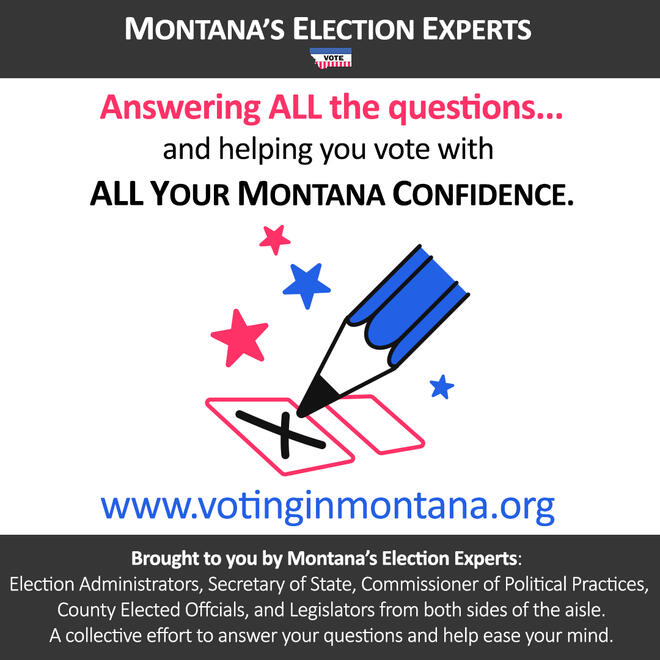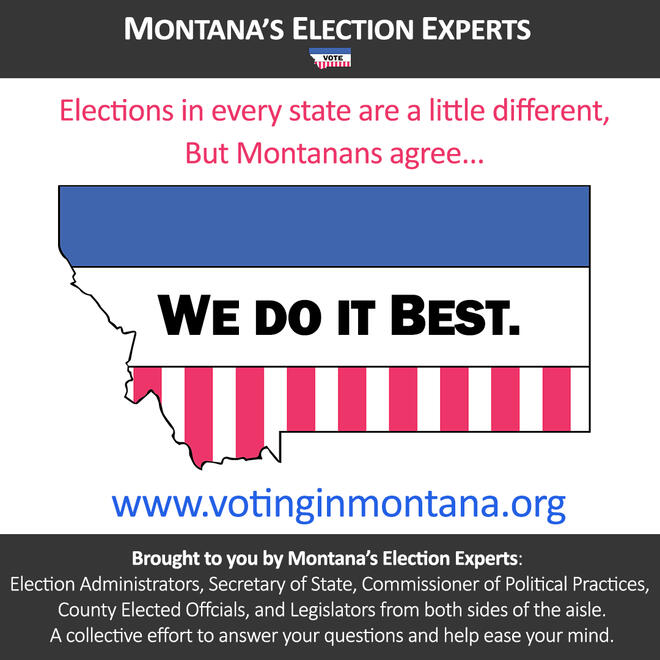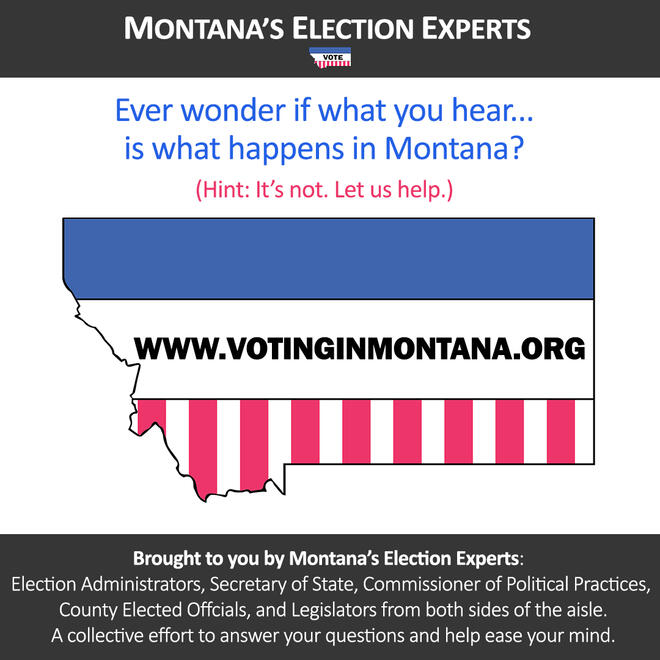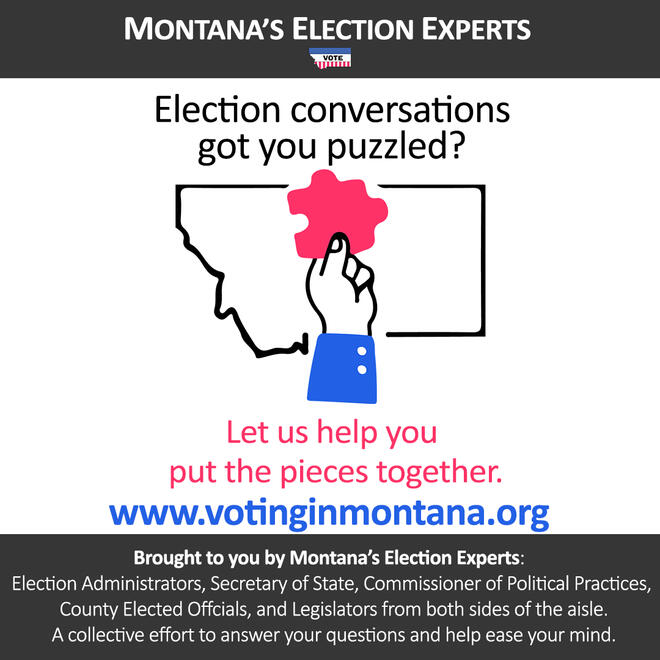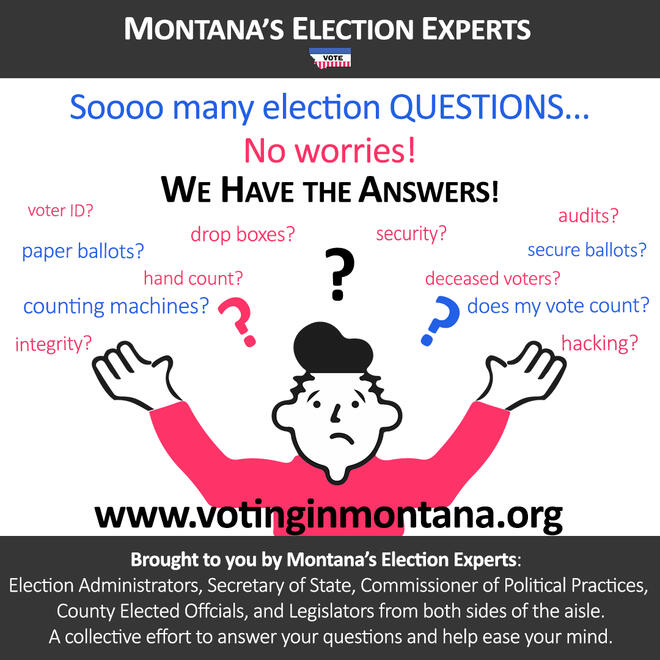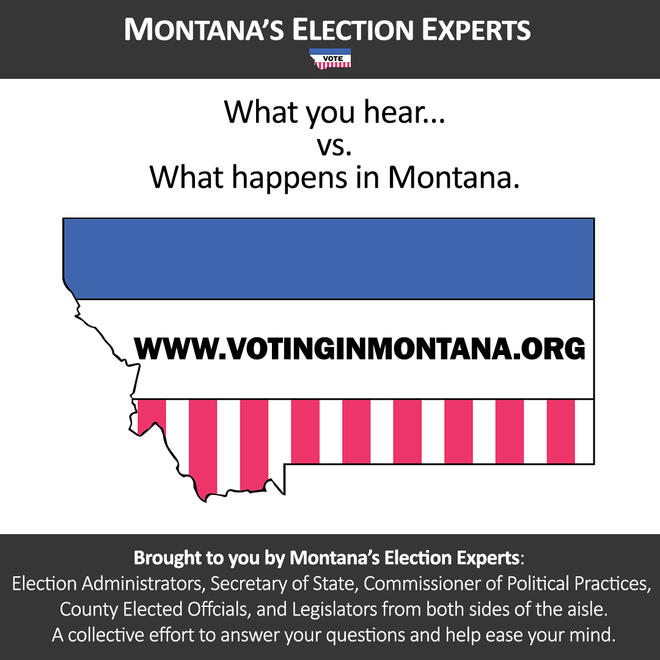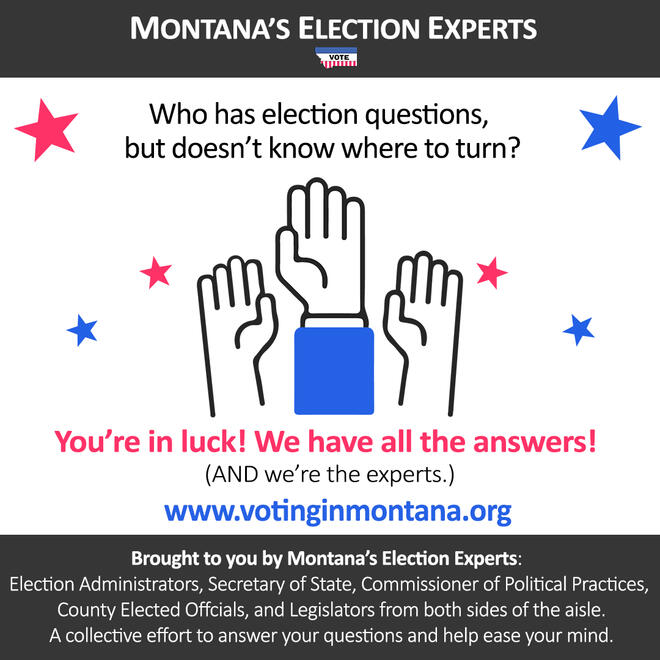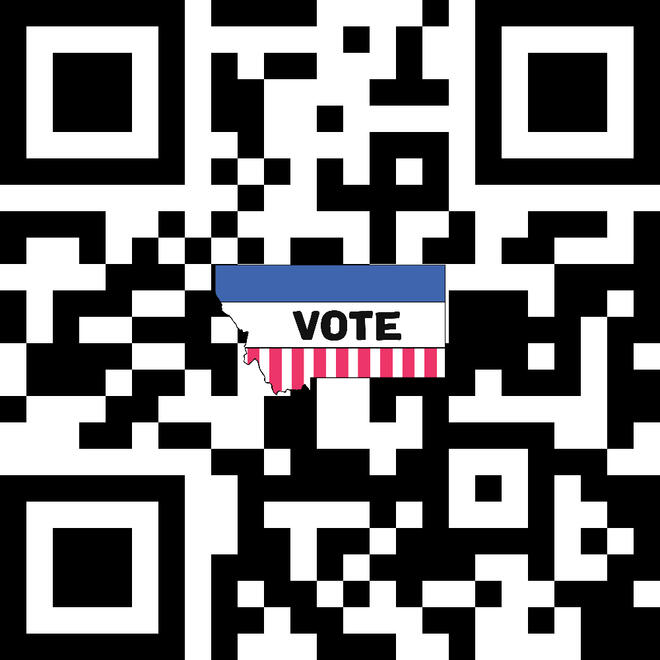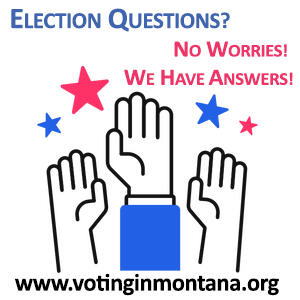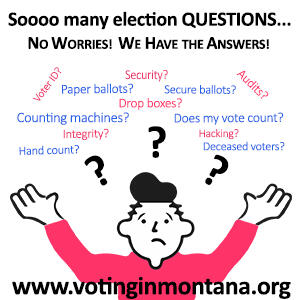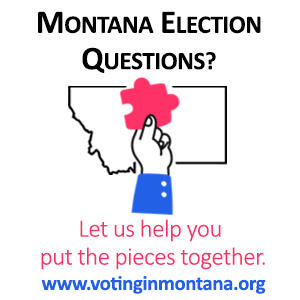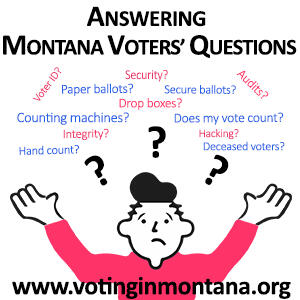Montana Voter Information
Myth vs. Fact
Provisions of the Montana Constitution, the Montana Code Annotated (MCA), and Administrative Rules (ARM) adopted by the Secretary of State address election security and voter identification and privacy. They prescribe certain protections and protocols; require swearing of oaths, training, and equipment requirements; and provide directives to local election administrators. The MCA provides penalties for violations of the laws.
We have compiled a comprehensive 'Myth vs. Fact' FAQ
Myth vs. Fact
Have Questions on Montana Election Integrity? Check out the FAQ!

We Can Help
Make a Plan to Vote!
Check your Voter Status or Register to Vote!


Be Election Ready - Check your Voter Status!
With My Voter Page, you can verify your voter information prior to election day. Have you recently moved? Changed your last name? Add or drop a PO Box? Haven’t voted in a while?Make sure your registration is up to date with My Voter Page!

Register to Vote!
Counties are always preparing for the next election. Do you have a plan to vote?Registering to vote is the first step.

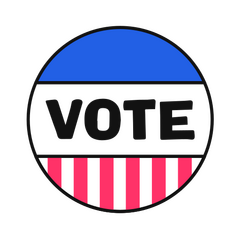
Where Do I Vote
Your voter registration confirmation card lists the location of your polling place. If you’ve misplaced your card, call your local election administrator to find out where to vote or, for federal/state elections, check your polling place location on-line at My Voter Page.
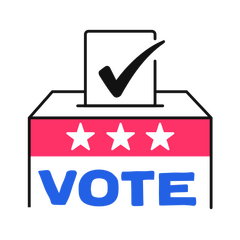
Voting By Mail/Absentee
There are a lot of pluses to voting by mail. You have the convenience of voting at home, time to research candidates on the ballot, avoid Election Day lines, and more. Sign up for vote by mail today!

Ballot Issue Information
The Montana Secretary of State has a page dedicated to ballot issue information. Please check with your election office for information on local ballot measures.

Accessible Voting
If you are a voter with a disability, there are options for you to independently cast a ballot.
Visit the Montana SOS website for information on the Electronic Ballot Request System (EBRS)

Military & Overseas Voting
The Uniformed and Overseas Citizens Absentee Voting Act (UOCAVA) created special provisions to make voting easier for members of the armed forces or certain overseas U.S. citizens.

Election Administrators
The staff in your county elections office want to help you make your vote count. If you are not sure where to start or just want to talk with a real live person about your voting questions, call or email your county elections office.

Election Calendars
The SOS’s Election Calendar provides details on testing deadlines and numerous other election-related deadlines that apply to voters, candidates, election administrators, and the Secretary of State.The SOS’s Election Calendar provides additional voter information and links for subjects like polling places, ID requirements, registration, and provisional ballots.
NEW in 2023 My Voter Page becomes ElectMT in the Spring of 2023
✓ Visit Montana's Secretary of State and Commissioner of Political Practices websites for additional information!
About votinginmontana.org
Who Are We
VotinginMontana.org is a project of the Montana Association of Clerk & Recorders and Election Administrators. The material was developed by the 2022 Election processes work group that included Montana Legislators, the Montana SOS, the Montana COPP, MACO, Montana County Attorneys, and other interested parties.
✓ Fully Transparent
No Public Funds
No public funds were used in the creation or maintenance of the website. The domain registration, hosting platform, and website development was donated by Jeff Mangan with personal funds & time. Shantil Siaperas, MACo & MACREA, is the site administrator.
HOW TO
How to Register to Vote in Montana
Qualifications to Vote in Montana
A United States citizen.
You must be 18 years or older.
A Montana resident for at least 30 days before the next election.
Voter Registration Form
If you meet the qualifications, you can vote!Click here to print off the form.All required portions of the form must be completed. This form can update your address or sign you up for mail ballots.
Returning the Form
Wet sign your registration form with a pen (no electronic signatures), then return it to your local election office. Click here for your county election office's contact information.You'll receive confirmation by mail that your application was accepted in the form of a Voter Confirmation Card. The card will include your voting districts and polling place location. You can also confirm your registration online at MyVoterPage.To register for an election less than 30 days away, you must provide your application in person at your county's designated "late registration" location.
Who is eligible to vote?
Montana’s constitution and state laws establish the eligibility requirements to become a qualified elector in Montana. A person must register as provided by law and by rules promulgated by the Secretary of State (SOS). Montana Code Annotated (MCA) 13-1-111 provides that to register to vote, a person must be 18 years of age or older on or before the next election; a resident for at least 30 days of the state of Montana and the county in which the person intends to vote; and a citizen of the United States.An applicant may not be registered to vote by an election administrator unless the applicant provides, and the election administrator verifies, the required information which includes a Montana driver’s license number; state ID card number; or the last four digits of the person’s social security number. If an applicant is unable to provide that information, other acceptable forms of identification are a military ID card; a tribal photo ID card; a United States passport; or Montana concealed carry permit. An applicant may alternatively provide any other form of photo identification including but not limited to a school district or postsecondary education photo ID, along with a current utility bill, bank statement, paycheck, government check, or other government issued document that shows the applicant’s address.The person must provide the person’s address of residence, mailing address, and previous registration information to ensure cancellation of registration in the person’s former jurisdiction. The applicant’s residential address or other residential geographic information an applicant provides must be easily verifiable or an applicant’s registration status will be considered incomplete.Finally, the individual must swear, under penalty of state and federal law, that the individual is a citizen of the United States who meets the voter eligibility requirements:I affirm under penalty of perjury that the information on this application is true, that I am a citizen of the United States, that I will be at least 18 years old on or before the next election, that I will have been a resident of Montana for at least 30 days prior to the next election, and that I am not serving a felony conviction in a penal institution nor have been found to be of unsound mind by a court. I understand that if I have given false information on this application, I may be subject to a fine or imprisonment, or both, under federal and/or state law.Falsification of information on a person’s voter registration form constitutes a violation of law, including deceptive election practices as provided in MCA 13-35-207. The penalties include a fine, imprisonment, or both.To receive and cast a ballot in person, a registered elector must present to an election judge a Montana driver’s license; a Montana state ID card; a tribal photo ID card; a United States passport; or a Montana concealed carry permit. Alternatively, an elector may present a utility bill, bank statement, paycheck, government check, or other government document along with a photo ID showing the elector’s name. A school district or postsecondary education photo ID is an acceptable form of photo identification.Federal laws prohibit a noncitizen from casting a ballot in federal elections for President or congress. Some of the penalties for violation of federal law include deportation, exclusion from the United States, and prison time and fines, as provided in 8 USC § 1182 and §1227, and 18 USC § 611.See SOS Administrative Rules of Montana (ARM) 44.3.2005 for additional information regarding voter registration application requirements.
Can voters register under fake names, register multiple times, on behalf of other people?
No. It is illegal to register under fake names, register multiple times, or register on behalf of other people. Such unlawful registration can result in a fine, imprisonment, or both.To ensure that voter registrations are tracked and prevent people from registering multiple times, the SOS maintains a single, official, centralized statewide voter registration system that meets federal requirements. State law (MCA 13-2-108) and SOS rules (ARM 44.3.1102) provide specific requirements for election administrators (instruction manuals, user guides, and technical manuals) regarding maintenance of the system, accuracy of the information, and requirements for entering information into the system as well as protecting electors’ information.SOS rules require election administrators to coordinate with the Social Security Administration, the state’s Motor Vehicle Division of the Department of Justice, and any other appropriate agency to verify voter registration information.Election administrators must use an applicant’s provided identification information as a unique identifier in addition to the voter registration number assigned to the elector.
How are voter addresses maintained, for example when a voter moves?
MCA 13-2-220 requires that rules adopted by the SOS) include procedures that election administrators must follow annually to ensure electors’ accurate addresses. These procedures include:1. Comparing the list on an annual basis of registered electors against the National Change of Address files and providing confirmation notice to the electors’ addresses that appear to have changed;2. Mailing a non-forwardable, first-class “return if undeliverable—address correction requested” notice to all registered electors of each jurisdiction to confirm addresses;3. Sending a targeted mailing to electors who failed to vote in the preceding general federal election, applicants who failed to provide adequate address information on voter registration forms, and provisionally registered electors.4. Sending a forwardable confirmation notice to voters whose ballot is returned undeliverable. Mail ballots themselves are non-forwardable, and a ballot will only be resent if the completed confirmation notice is received by the election department. If a confirmation notice is returned undeliverable, the voter is placed on the inactive list.Electors who fail to respond or confirm addresses or who have provided an address from which notification is returned as undeliverable are moved to the inactive list. Persons on the inactive list do not receive mail or absentee ballots.A voter can be reactivated by submitting a Voter Registration Application to the election department.
How are voters assigned to a precinct?
The county governing body establishes precinct boundaries and, if the governing body modifies a boundary, it must provide the legal description and map of the new boundaries to the election administrator (MCA 13-3-101 through MCA 13-3-103).Measures are taken using the statewide voter registration list, precinct maps, and legal descriptions to assign voters to the appropriate districts and prepare a precinct register for each precinct in the county for use by the election judges. For all elections other than mail ballot elections, the election administrator must prepare from the statewide voter registration list a precinct register for use by the election judges. Precinct register requirements are enumerated in MCA 13-2-116.
FUN FACT
Mail ballot elections are not allowed for regularly scheduled federal, state, or county election; nor for a special federal or state election or a regularly scheduled or special election when another election in the political subdivision is taking place at the polls on the same day (MCA 13-19-104). This is not to be confused with absentee voting. (For more information on absentee voting, see “What is absentee voting and how does it work in Montana?”)
What is the process for a deceased voter?
Montana has numerous checks and balances among county coroners, the Department of Public Health and Human Services (DPHHS), the SOS, and county clerk and recorders. Below is a summary of these processes:1. All deaths are reported to the DPHHS Office of Vital Statistics by the county coroner.2. Each month DPHHS prepares a list for the SOS which is then integrated into the voter registration database. The list includes all reported deaths and the associated date of death. (Quarterly reports are required; however, Montana exceeds that requirement.)3. The list is forwarded to each county election administrator. The county election administrator must then cancel the applicable registrations upon receipt of the list, upon receipt of a voter’s death certificate, or upon publication of a newspaper obituary. As a practical matter, election officials regularly check obituaries and update their voter rolls. Montana’s election administrators also have access to the vital statistics system and can verify any deaths.Exception: If an elector dies after casting the elector’s absentee ballot before election day, MCA 13-13-204 requires the election administrator to count the deceased elector’s vote if it is returned and meets all the absentee ballot security requirements.Montana also has criminal penalties for casting the ballot of a deceased person provided in MCA Title 45, chapter 7, part 2. These penalties include a fine, imprisonment, or both. State law also provides for penalties for other offenses including false swearing, unsworn falsification, and/or tampering with public records or information (MCA 13-35-207). This activity may also be considered fraudulent registration under MCA 13-35-209.
What is absentee voting and how does it work in Montana?
Voting absentee means voting away from the polling place. A qualified elector must apply or make written request to vote absentee pursuant to Montana Code Annotated (MCA) 13-13-212.Below is a general summary of how voting absentee works (MCA Title 13, chapter 13, part 2).1. A qualified absentee voter (MCA 13-1-111) receives their paper ballot in the mail.2. The voter completes the ballot and places it in a secrecy envelope, which is free of any identifying marks.3. The voter then places the secrecy envelope into an affirmation envelope that includes a unique bar code—associated with the voter ensuring each qualified elector only receives one ballot—and signs the envelope on the line provided.4. The voter then returns the enclosed ballot either by mail or dropping it off at the voter’s election office or polling place within the county (MCA 13-13-201).5. When the enclosed ballot is received and checked in by an election administrator, the bar code on the affirmation envelope is scanned, which pulls up the voter’s information and signature.6. The election administrator verifies that the voter is legally registered and verifies the signature on the affirmation envelope matches the signature on the voter’s registration form or absentee ballot application.
NOTE When a registered voter applies to be an absentee voter, the signature from their registration form must match the one on the absentee ballot application they submit (MCA 13-13-213). Election administrators require election officials to complete signature verification training. The Secretary of State’s (SOS) Absentee Best Practices training materials include criteria for review of signatures and signature verification examples.
NOTE If the signature on the absentee ballot signature envelope does not match the signature on the absentee ballot request form or on the voter registration form, if there is no signature on the absentee ballot signature envelope, or if there is any question whatsoever of the validity, the election administrator shall notify the elector as provided in MCA 13-13-245.
7. If the signature is verified, the secrecy envelope is removed from inside its affirmation envelope and placed with other ballots that are still enclosed in their secrecy envelopes. The affirmation envelopes and secrecy envelopes are kept separate.
NOTE Secrecy envelopes remain closed until it is time for election officials to separate the ballots from the envelopes for the purpose of ballot preparation, which is open to the public under MCA 13-13-241. Ballots are stored in secure ballot boxes.
NOTE Local election offices use various additional measures to ensure that affirmation envelopes and secrecy envelopes remain separated as ballots are processed, so an individual ballot cannot be traced back to the voter.
8. The SOS has adopted rules designating the allowable distance from the observers to the judges and ballots; the security in the observation area; the secrecy of votes during the preparation of the ballots; and the security of the secured ballot boxes in storage until tabulation procedures begin.
Are drop boxes allowed in Montana?
Montana law does not provide for unattended drop boxes for either absentee voting or mail ballot elections. Any place of deposit must be staffed by election officials.Mail ballot elections are governed by MCA Title 13, chapter 19 and Administrative Rules of Montana (ARM) Title 44, chapter 9, subchapter 3. General election laws apply to mail ballot elections, and the election administrator must handle these ballots in the same manner as provided for absentee ballots. An elector or the elector’s agent or designee may return a ballot in a mail ballot election in person.MCA 13-19-307 requires election administrators to designate one or more places of deposit where ballots may be returned in person by an elector or the elector’s designee. Ballots may only be returned to a designated place of deposit during the days and times set by the election administrator. The places of deposit must be staffed by at least two election officials, and each place of deposit must have a secure ballot transfer box.MCA 13-19-308 requires election officials at the site of a place of deposit other than the election administrator’s office to maintain a log of the names of electors whose ballots are returned and secure the ballots until they are transported to the election administrator’s office.
How does voting in person work in Montana?
Voting in person means voting at a designated polling place. Below is a general summary of how voting in person works in Montana.1. A voter who is qualified under MCA 13-1-111 must show the voter’s identification as required in MCA 13-13-114 and sign the precinct register next to the voter’s name at the designated polling place. (For more information on designated polling places, see “How are voters assigned to a precinct?”)2. The qualified voter receives a paper ballot from the election judge and is guided to a booth for privacy in casting the ballot.
NOTE Montana’s disabled electors may vote via a voter interface device, which enables them to vote independently and privately (learn more here). These ballots are still printed for tabulating purposes.
3. Once the voter completes the ballot, the voter places it in a secrecy sleeve prior to placing the ballot in the polling place ballot box.
NOTE Election officers and election judges are prohibited from examining an elector’s ballot or looking at any mark made by the elector on the ballot before putting it in the ballot box.
Does my vote remain secret?
Yes. Article IV, Section 1 of the Montana Constitution provides that “All elections by the people shall be by secret ballot.” MCA 13-1-102 echoes that requirement.Montana has mandatory procedures for the handling of ballots by election administrators, election judges, and other election workers.Additionally, under Montana’s state laws and rules, no voting system may be approved unless it allows an elector to vote in secrecy.(See also: “What is absentee voting and how does it work in Montana?” and “What is in person voting and how does it work in Montana?”)
How do I know if my absentee ballot has been received by the county election office?
The SOS maintains a website called “My Voter Page”, where you can check the status of your absentee ballot in a federal election. The website will provide you with personalized information as to the date your absentee ballot was mailed to you and to what address it was sent. Once you vote and return your ballot, either in person or by mail, the system will be updated, and you can check your status. Updates occur daily. (If you vote via absentee ballot, allow the usual mail delivery time prior to checking and keep in mind election offices may be processing large volumes of ballots.)Upon receipt of a ballot, the local election office scans the unique barcode on the affirmation envelope, verifies the signature, and marks the ballot as “received.” Once your ballot has been processed, you will most likely see the status of your ballot is “accepted;” however, if you see a status of “rejected” or “undeliverable,” please contact your local election office immediately to resolve the issue so that your vote will be counted.
FUN FACT
The SOS is developing an improved election management system called ElectMT, which is scheduled to go live in January 2023. Don’t worry though! It will contain the same functionality of “My Voter Page.”
How do we ensure election results in Montana are valid?
Local elections offices have numerous protocols in place to ensure the validity of Montana’s elections, some of which are listed below:1. No ballots are removed or added at any time in Montana.MCA 13-13-115 requires the election administrator in each precinct to use a precinct register, pollbook, or some other method to record the number of individuals voting and the number of ballots cast that conforms to the method prescribed by the SOS in accordance with rules adopted pursuant to MCA 13-12-202. (See also: “Does my vote remain secret?” and “What is absentee voting and how does it work in Montana?” and “What is in person voting and how does it work in Montana?”)
NOTE A local counting board, provided for by law, must count all ballots to ensure that the total number of ballots corresponds with the total number of names in the pollbook. If the numbers do not match, the board must submit to the election administrator a written report stating how many ballots were missing or in excess and any reason for the discrepancy of which members are aware.
2. Chain of custody is immensely important and adhered to in Montana.County election offices adhere to chain of custody protocols to ensure that every ballot submitted is accounted for at every stage in the collection and tabulation process and that numbers of ballots distributed can be reconciled with the numbers of ballots returned or submitted.
NOTE Ballots for in-person voters include a stub that is removed when the voter presents a completed ballot. The county retains the stub separately from the ballot to ensure that the number of stubs matches the number of ballots submitted.
NOTE Not all absentee ballots include stubs, but election officials meticulously track the number of ballots sent with the number of ballots returned. In addition, returned absentee ballots include a bar code that is scanned and directs the election worker to the elector’s voter ID and signature which must be verified for the ballot to be counted.
3. Public postelection audits are required in Montana.The “Postelection Audit Act” (MCA Title 13, chapter 17, part 5) and rules adopted by the SOS require public post-election, random-sample audits of vote-counting machines after unofficial results are made available to the public and before the official canvass. The purpose of the postelection audit is to perform a quality assurance check to verify that tabulators used to count ballots functioned appropriately during the election.
NOTE The ten counties that hand count ballots—as well as those counties that have a race with a potential recount—are exempt from the postelection audit for the election.
The postelection audit has three basic steps (includes a fourth step, if necessary):i. Counties appoint members of the “county audit committee.”
Prior to the election, the governing board of each county that may be required to perform the Postelection Audit (those utilizing tabulators) appoints at least three individuals to serve on the “county audit committee.” The committee may not include a person who served as an election judge in the election, a person employed by the vendor who supplied the tabulator, or a person who has performed maintenance on the tabulator.ii. Races and precincts are randomly selected.
The State Board of Canvassers (State Auditor, Attorney General, and Superintendent of Public Instruction) meets within seven to nine days after the election to randomly pick the races and precincts in each county to be audited. To ensure randomness, the selection is done by board members rolling dice. After the races and precincts are selected, the information is posted online and sent to each county.iii. County audit committee conducts the audit.
The county audit committee then meets at least one day before the county canvass to conduct the audit. The audit committee proceeds to manually count the votes for the randomly selected races and precincts in the county. If the manual count and the tabulator totals match, then the county audit committee shall certify the results to the election administrator. If the totals don’t match, then the audit committee proceeds to the next step.iv. The “Only if Necessary” Step…
If the random-sample audit results in a discrepancy of more than 0.5% of total ballots cast or five ballots, whichever is greater, and if the discrepancy is determined to be due to the vote-counting machine (tabulator) and not to administrative or user error, then the following ensues:1. The tabulator involved in the discrepancy may not be used in another election until it has been examined and tested by a computer software expert in consultation with a voting system vendor and approved by the secretary of state.2. Also, three additional precincts within the county must be audited for the office or ballot issue in question. If the county has fewer than three additional precincts, all remaining precincts must be audited.3. If the audit of the additional precincts results in a discrepancy for those precincts of more than 0.5% of total ballots cast or five ballots, whichever is greater, and if the discrepancy is determined to be due to the tabulator and not to administrative or user error, the tabulator involved in the discrepancy in that county may not be used in another election until it has been examined and tested by a computer software expert in consultation with a voting system vendor and approved by the Secretary of State.4. Per MCA 13-15-403 (4), if during a canvass the board finds an error in a precinct or precincts affecting the accuracy of vote totals, the board may immediately petition for a recount of the votes cast in the precinct or precincts, as provided in MCA 13-16-201, or for an inspection of ballots, as provided in MCA 13-16-420.To learn more about the 2022 primary postelection audit, click here to review an information sheet prepared by Montana’s SOS.See also “Does my vote remain secret?” and “What is absentee voting and how does it work in Montana?” and “What is in-person voting and how does it work in Montana?”Refer to the below resources for additional details regarding ballot security and requirements for chain of custody and ballot reconciliation:1. SOS ARM 44.3.2904;2. Example from Yellowstone County of election judge invitation letter stating training is required and SOS Election Judge Training Document; and3. Example from Yellowstone County of flow of ballots from collection through tabulation to secure endpoint, including links to SOS-required recordkeeping.
Can election workers in Montana tamper with the election by altering the markings on a ballot?
No. Ballot processing and vote counting must occur in a public area under the care of trained election officials who have sworn an oath. MCA 13-35-207 provides for penalties for falsely swearing an oath. In addition, poll watchers are provided for by state law.The requirements, enacted by the legislature and further detailed in rules adopted by the SOS, for processing ballots are all intended to safeguard the integrity of an elector’s ballot and prevent tampering. (See also “Does my vote remain secret?” and “What is absentee voting and how does it work in Montana?” and “What is in person voting and how does it work in Montana?”)MCA 13-35-205 prohibits tampering with election records and information, including causing a vote to be incorrectly recorded or changing any ballot after it has been completed by an elector. The offense is punishable as provided in MCA 45-7-208, and includes a fine, imprisonment, or both.
ELECTION INTEGRITY
Frequently Asked Questions
Myth versus Fact - Voting Equipment and Systems (PDF Link)
What processes are in place in Montana to ensure tabulating machines and voting systems are sound and prevent fraud and that machines work properly, do not mishandle ballots, and cannot be hacked or manipulated?
Montana has multiple systems in place to ensure that all elections are sound and to prevent fraud.1. Every vote in Montana is cast on a paper ballot. The ballots are secured and retained for a minimum period of time as prescribed in Montana Code Annotated (MCA) 13-1-303 (22 months for federal elections and 12 months for local elections, and ballots can only be accessed via a court order).
NOTE Montana’s disabled electors may vote via a voter interface device, which enables them to vote independently and privately (learn more here). These ballots are still printed for tabulating purposes.
2. Administrative Rules of Montana (ARM) 44.3.2905 prohibits any type of component used within a voting system from being connected to a computer network at any time.3. Pursuant to MCA 13-17-212 and ARM 44.3.1713, within 30 days of an election in which a voting system is used, election administrators must conduct public testing of the voting systems and certify on a form provided by the Secretary of State (SOS) that they are performing properly.
NOTE The SOS’s Election Calendar/s provides details on testing deadlines and numerous other election-related deadlines that apply to voters, candidates, election administrators, and the SOS.
FUN FACT
For the 2022 General Election, October 11th marks the beginning of the period during which the public tests must occur. If automatic tabulation begins the day before the election, election administrators must publicly test all central count vote machines.
Voting System RequirementsMontana’s tabulators and other voting systems are built to Montana’s specifications pursuant to Montana law. MCA Title 13, chapter 17 and ARM Title 44, chapter 3, subchapter 17 prescribe voting machine and voting system requirements, including acquisition and use of systems, engagement of qualified technicians, required specifications and approval criteria, training, and post-election audits.A voting system may not be used unless it is approved by the SOS, who is required to oversee the examination of the systems by qualified technicians. The SOS may not approve a voting system unless it meets specific criteria pursuant to MCA 13-17-103, including allowing voting in secrecy, preventing an elector from voting more than once, and preventing an elector from voting on a candidate or ballot issue for which the elector is not entitled to vote. A system may not be approved if it is not protected from tampering for a fraudulent purpose.A voter interface device utilized by disabled electors must meet specific security standards, and the SOS has adopted rules for performance standards that must be met in tests prior to approval.The SOS must also adopt rules that specify the security measures necessary to secure the voting system before, during, and after an election. Election administrators must perform public, random testing and certification of voting systems.
Postelection audits are required in Montana.The “Postelection Audit Act” (MCA Title 13, chapter 17, part 5) and rules adopted by the SOS require public post-election, random-sample audits of vote-counting machines after unofficial results are made available to the public and before the official canvass. The purpose of the postelection audit is to perform a quality assurance check to verify that tabulators used to count ballots functioned appropriately during the election.
NOTE The ten counties that hand count ballots—as well as those counties that have a race with a potential recount—are exempt from the postelection audit for the election.
The postelection audit has three basic steps (includes a fourth step, if necessary):i. Counties appoint members of the “county audit committee.”
Prior to the election, the governing board of each county that may be required to perform the Postelection Audit (those utilizing tabulators) appoints at least three individuals to serve on the “county audit committee.” The committee may not include a person who served as an election judge in the election, a person employed by the vendor who supplied the tabulator, or a person who has performed maintenance on the tabulator.ii. Races and precincts are randomly selected.
The State Board of Canvassers (State Auditor, Attorney General, and Superintendent of Public Instruction) meets within seven to nine days after the election to randomly pick the races and precincts in each county to be audited. To ensure randomness, the selection is done by board members rolling dice. After the races and precincts are selected, the information is posted online and sent to each county.iii. County audit committee conducts the audit.
The county audit committee then meets at least one day before the county canvass to conduct the audit. The audit committee proceeds to manually count the votes for the randomly selected races and precincts in the county. If the manual count and the tabulator totals match, then the county audit committee shall certify the results to the election administrator. If the totals don’t match, then the audit committee proceeds to the next step.iv. The “Only if Necessary” Step…
If the random-sample audit results in a discrepancy of more than 0.5% of total ballots cast or five ballots, whichever is greater, and if the discrepancy is determined to be due to the vote-counting machine (tabulator) and not to administrative or user error, then the following ensues:1. The tabulator involved in the discrepancy may not be used in another election until it has been examined and tested by a computer software expert in consultation with a voting system vendor and approved by the secretary of state.2. Also, three additional precincts within the county must be audited for the office or ballot issue in question. If the county has fewer than three additional precincts, all remaining precincts must be audited.3. If the audit of the additional precincts results in a discrepancy for those precincts of more than 0.5% of total ballots cast or five ballots, whichever is greater, and if the discrepancy is determined to be due to the tabulator and not to administrative or user error, the tabulator involved in the discrepancy in that county may not be used in another election until it has been examined and tested by a computer software expert in consultation with a voting system vendor and approved by the Secretary of State.4. Per MCA 13-15-403 (4), if during a canvass the board finds an error in a precinct or precincts affecting the accuracy of vote totals, the board may immediately petition for a recount of the votes cast in the precinct or precincts, as provided in MCA 13-16-201, or for an inspection of ballots, as provided in MCA 13-16-420.To learn more about the 2022 primary postelection audit, click here to review an information sheet prepared by Montana’s SOS.See also “Does my vote remain secret?” and “What is absentee voting and how does it work in Montana?” and “What is in-person voting and how does it work in Montana?”Refer to the below resources for additional details regarding ballot security and requirements for chain of custody and ballot reconciliation:1. SOS ARM 44.3.2904;2. Example from Yellowstone County of election judge invitation letter stating training is required and SOS Election Judge Training Document; and3. Example from Yellowstone County of flow of ballots from collection through tabulation to secure endpoint, including links to SOS-required recordkeeping.
SOS Election Security and Voting Machine Examination RulesHouse Bill 530, enacted by the 2021 Legislature and codified as MCA 13-1-205, requires the SOS to adopt rules regarding election security. The rules, adopted at the end of June 2022 and located in ARM 44.3.29, are summarized below.1. The rules require annual assessments of county election office security practices. Every three years, the assessment must be conducted by an independent, third-party, qualified assessor.2. The rules require county election staff to complete annual security awareness training administered by the SOS. Election office staff must keep records of the training and provide them to the SOS.3. The rules require that voting system components be physically secured “using tamperproof seals and access control” and require election administrators to maintain a chain of custody for voting system components and for other security devices. The rules require that ballot reconciliations be conducted before the official county canvass and recommend surveillance of rooms where ballots are being handled and processed.4. The rules prohibit components of a voting system from being connected to a computer network at any time and require additional security measures for computers used by county election staff.
Where can I go online to review my voter registration information?
The status of your registration on the Secretary of State’s (SOS) My Voter Page is always available. Check your registration status well before an election. Pay particular attention to your absentee voter status so you know if you should expect a ballot in the mail or will need to vote in person for certain elections.If you notice any irregularities, be sure to contact your local election official. Also, if you move or get a new post office box, you need to update your voter registration with your local elections office.
I like to vote in person. How do I find out where to vote?
You can check your polling place location online at the SOS My Voter Page. Your voter registration confirmation card also lists the location of your polling place. If you’ve misplaced your card, call your local election administrator to find out where to vote.Additionally, the SOS offers instructions and tips on voting at the polling place. If you’re unable to drive to the polls yourself, contact your county election office for voting options, including voting by absentee ballot, or getting a ride from a community service organization that may be providing transportation in your community.
What can I do to make sure my ballot is counted, and if I vote absentee, how do I make sure it isn’t lost in the mail?
Make sure you are registered to vote regardless of if you vote in person or absentee. Pay attention to deadlines and make sure you fill out your ballot correctly.1. Check your registration status.Visit the SOS My Voter Page and check your registration status. Also be sure the correct address is listed because this will determine your precinct polling place for in-person voters, and it’s where your absentee ballot will be mailed if you’re an absentee voter. If you notice any irregularities, be sure to contact your local election official.
IMPORTANT If you move or get a new post office box, you need to update your voter registration with your local elections office. If you aren’t registered, go to your local elections office and get registered!
2. Pay attention to deadlines for registration and for ballot returns.If you aren’t registered, pay attention to deadlines for voter registration and ballot returns, which are provided on the SOS voter information page. It’s also beneficial to review the 2022 Primary and General Election Calendar, pay attention to notices in your local newspaper, check your county’s social media page if they have one, and if all else fails, call your local elections office.3. Make sure you fill out your ballot correctly.Don’t fill in multiple ovals for candidates in the same race. This is called an “overvote” because you voted for too many people in the same race, and it will not count. In addition, do not put any pen marks in ovals you do not intend to mark or it might be considered an overvote, and you now know what that means! Just be careful with pen marks.Specifically for Absentee VotersIf you HAVE NOT received your absentee ballot…To ensure your ballot didn’t get lost in the mail or that your address is correct or that you are indeed registered to vote absentee, go to the SOS My Voter Page, where you can check the status of an absentee ballot in a federal election. The website will provide you with personalized information as to the date your absentee ballot was mailed to you and to what address it was sent.
NOTE Updates to the system occur daily.
NOTE The system is for all voters, so in-person voters can check their registration status and see their assigned precinct.
If you HAVE received your absentee ballot…1. Mark the ballot as instructed.2. Put the ballot in the secrecy envelope and put the secrecy envelope in the affirmation envelope. Make sure it has YOUR name on it and not your spouse’s or house-mate’s name if they too vote absentee.3. After you’ve verified your name on your affirmation envelope, sign it carefully on the designated line. Your careful signature is important because your signature will be compared with the signature on file from your voter registration form/absentee voter application to ensure you completed your own ballot.4. Lastly, seal it up and return it either via mail or by dropping it off at your county’s election office or a polling place within your county. You can check the status of your ballot on the SOS My Voter Page.
NOTE Updates to the system occur daily, but the status of your ballot will not change until it is entered into the system, the timing of which may depend on mail delivery and volume of ballots being processed in the election office.
NOTE The system is for all voters, so in-person voters can also check their ballot status and see their assigned precinct.
There is so much information on the Internet and social media. I want to ensure I’m receiving reliable information, so who do I go to if I have questions or concerns?
Don’t rely on social media. Start with your local elections office in your county. You can check their website, and if you are unable to find the answers you need, give them a call! Elections staff are always happy to answer your questions.Additionally, the SOS elections website is a valuable resource that offers information regarding all aspects of voting, including registration, ballot status, absentee voting, ballot issues, and candidate contact information.Get your hands on and read the SOS Voter Information Pamphlet containing information on ballot issues and initiatives. This is sent to all registered voters. The SOS provides names and contact information for candidates, but it is up to you as an elector to research the candidates’ positions to determine who gets your vote. Contact the candidate who is seeking your vote (they’re running for office, so they visit with their potential and/or existing constituents regularly). You can also check out their websites for clarification on their positions.
What if I witness suspicious activity or what I think may be a violation of election laws?
If at a polling place seek out an election judge or an election official and report what you saw. You can also report an alleged violation to your local County Attorney and/or the Montana Commissioner of Political Practices, who share jurisdiction over Montana election and voter fraud laws.
DID YOU KNOW?
✓ Violation of laws governing electors and election administrators is provided for in Montana Code Annotated (MCA) Title 13, chapter 35, parts 1 and 2. They include tampering with public records or information, official misconduct, obstruction of a public servant, criminal mischief, and false swearing, among others.
✓ Montana’s elections are administered by certified elected or appointed officials with the assistance of trained volunteers who are your neighbors and members of your community.
✓ Election judges are recruited locally and are required to attend training.
✓ Election officials swear an oath, and although specific protocols vary from county to county, all election officials who swear an oath must adhere to state law and rules adopted by the Secretary of State (SOS).
✓ Volunteers receive a small stipend for their time and they work under supervision.
✓ MCA 13-15-206 governs in detail how your ballots must be handled and counted by election officials, whether by a manual count or with the use of a tabulator.
✓ Counties that utilize tabulators hold a public audit.
✓ MCA 13-13-120 requires poll watchers to be allowed close to the poll. One poll watcher from each political party must be admitted, and additional poll watchers may be added if space allows.
✓ Montana’s counties are responsible for the entire cost of elections, whether they are federal, state, or county.
✓ The SOS is responsible for training election administrators, prescribing election forms, providing advisory opinions, and seeking advice from election administrators on ways to promote voter confidence in election integrity.
✓ The SOS and county election administrators are required to annually assess their compliance with the SOS’s election security rules. County election administrators shall provide the results of the confidential security assessments to the SOS in January of each year to ensure that all aspects of elections in the state are secure. Beginning January 1, 2023, and annually, the SOS is required to provide to the legislature’s State Administration and Veterans’ Affairs interim committee a summary report on statewide election security.
✓ Montana’s election systems are built according to Montana law. Additionally, they are not allowed to be connected to a network at any time.
✓ Montana uses only paper ballots.
Montana Secretary of State, Christi Jacobsen
Main Website: sosmt.gov
Main Phone: 406-444-2034
Elections Office Phone: 406-444-9608
Elections Office Email: soselections@mt.gov
Montana Election Administrators
Montana Election Administrator Contact Information (PDF): Local Election Administrator Contact Information by County
Montana Association of Clerk & Recorders and Election Administrators
Website: votinginmontana.org
MACR President: Vera Pederson, Sweet Grass County Clerk & Recorder/Election Administrator
Phone: 406-932-5152
Email: sgclerk1@itstriangle.com .
Montana Association of Counties
Shantil Siaperas, Communications Director
Phone: 406-449-4360
Email: shantil@mtcounties.org
Montana Commissioner of Political Practices, Jeff Mangan
Main Website: politicalpractices.mt.gov
Main Phone: 406-444-2942
Email: cpphelp@mt.gov
✓ Glossary of Election Terminology, U.S. Election Assistance Commission

